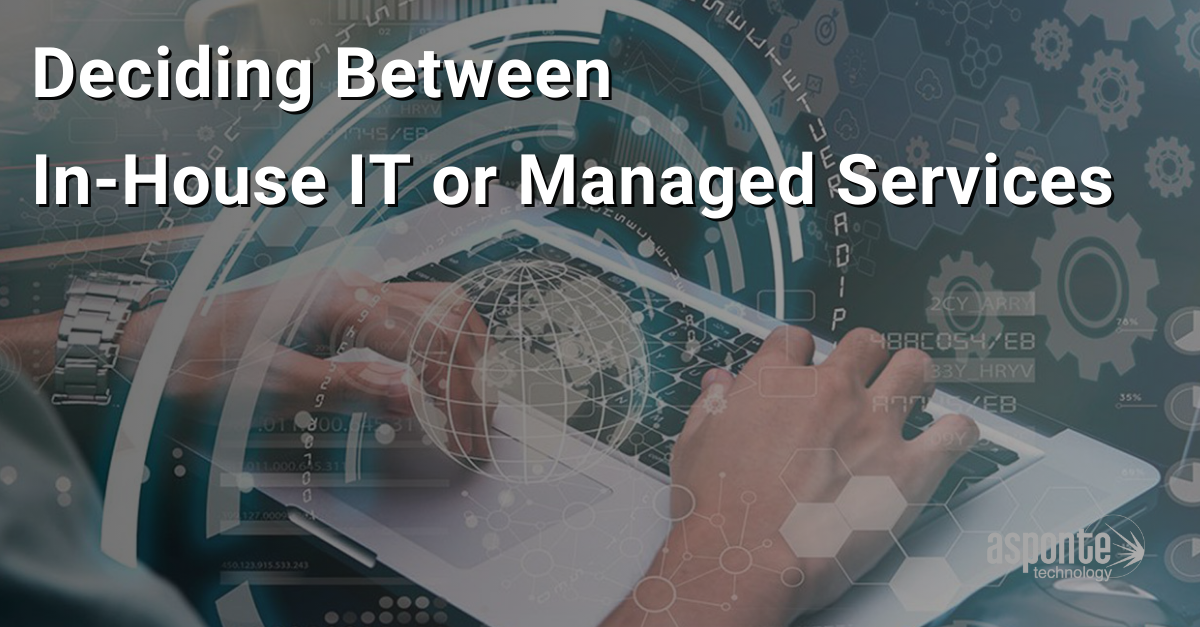The decision between hiring an in-house IT team or outsourcing to a managed services provider (MSP) is a challenging one for businesses of any size. From cybersecurity to network management and from software development to data analytics, IT is a fundamental part of day-to-day operations. This is not a one-size-fits-all question; the answer depends on a variety of factors specific to your organization’s size, needs, and future growth plans. Whether working with a small startup on a tight budget or a well-established enterprise looking to scale, we find ourselves discussing 7 key factors with potential clients.
Key Factor 1: Cost
Cost is often the first, and most revisited, consideration when deciding between in-house and managed IT services. An in-house IT solution needs staff which necessitate salaries and benefits, even before considering the overhead costs of the technology itself.
On the other hand, MSPs typically offer various pricing models that can be tailored to fit any budget, making it easier to achieve a better return on investment compared to keeping a full IT team on your payroll.
Key Factor 2: Skill Sets and Expertise
An in-house IT team may have an excellent understanding of your specific needs, but keeping them updated on the latest technologies might be both time-consuming and expensive.
For example, if your company relies on custom-built software, an in-house team would likely be more adept at handling issues related to that software. They would already know all the quirks and idiosyncrasies of your hardware and network setup.
However, keeping an in-house team updated on broader technological advancements can be challenging. Training programs and certifications can add up quickly, both in terms of time and financial resources.
MSPs, however, are in the business of IT; they specialize in maintaining a high level of expertise and can offer a wider array of specialized skills.
Key Factor 3: On-Site Availability
The advantage of in-house IT is immediate, on-site assistance. For instance, let’s say you’re in the middle of an important client presentation when suddenly your network crashes. If you have an in-house IT team, you could potentially have the issue resolved within minutes because the team is right there, in the building!
However, an in-house IT solution is often limited to business hours. MSPs usually offer 24/7 support, remote assistance ensuring that help is just a phone call away, any time of the day or night.
So to the client we may ask– Do you frequently find yourself in time-sensitive situations where immediate on-site troubleshooting is essential? Or are your needs generally met with remote support?
Key Factor 4: Scalability
As your business grows, so will your IT needs. An in-house IT team can become a bottleneck if it doesn’t scale with the rest of the organization.
Imagine you open the doors with a small team of five people and use an in-house IT expert to manage your systems. Initially, your setup might work fine. However, as you grow to 50 or 100 employees, your single IT specialist will likely struggle to manage the increased workload, from more frequent troubleshooting to a greater need for system updates.
You could expand your in-house team, which would involve new hiring processes, training, and the creating space for your new personnel.
MSPs offer scalable solutions that can grow with your business. The MSP can quickly adapt their service offerings to fit your expanding needs, allowing you to focus on your core business activities.
Key Factor 5: Control Over IT Systems
Complete control over your IT systems is one advantage of an in-house team. You set the priorities and direct the work. With in-house IT, you’ll have complete oversight and immediate control over your security protocols, data storage, and who has access to what information. You can also implement changes on the fly and adapt security measures to suit specific needs.
With an MSP, you may need to give up some level of control, but often this trade-off is worth the specialized services and 24/7 support you receive. They can implement security patches and updates as part of their standard operations, often without needing your direct involvement.
Key Factor 6: Response Time
The efficiency of your business can be heavily influenced by the response time of your IT support. You could potentially get immediate attention, as your team is already on-site.
However, in-house teams might not be as quick off-hours, while many MSPs offer minimum response time guarantees 24/7, usually ranging from 10 minutes to an hour.
Even though they’re not on-site, their remote support capabilities can often resolve issues swiftly, sometimes even before you realize there is a problem.
Key Factor 7: Knowledge of Company Infrastructure
In-house IT professionals often have a deep understanding of your specific business needs and systems. In-house IT teams work closely with your system all day, every day. Naturally, they will develop an understanding of how even the smallest IT issue can impact various parts of your business. When a problem arises, they can quickly pinpoint the root cause and implement a solution that considers the company’s unique infrastructure.
While this could be a limitation for MSPs, many make up for it by conducting thorough initial assessments and ongoing evaluations. Also, MSPs often have experience across a wide range of industries and could quickly get up to speed or may already have the solution you need!
Choosing between in-house IT and an MSP involves several considerations—cost, skill sets, availability, scalability, control, response time, and knowledge of your business. Each organization will prioritize these factors differently based on their unique needs.
Still undecided? Contact Asponte Technology for more personalized advice to make this critical decision for your business easier.




